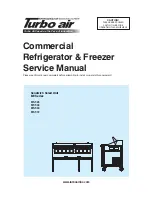
12
Understanding Sounds
You May Hear
Your new refrigerator may make sounds that your old one
didn’t make. Because the sounds are new to you, you
might be concerned about them. Most of the new sounds
are normal. Hard surfaces, like the floor, walls, and
cabinets, can make the sounds seem louder than they
actually are. The following describes the kinds of sounds
and what may be making them.
■
If your product is equipped with an ice maker, you will
hear a buzzing sound when the water valve opens to fill
the ice maker for each cycle.
■
The defrost timer will click when the automatic defrost
cycle begins and ends. Also, the thermostat refrigera-
tor control, will click when cycling on and off.
■
Rattling noises may come from the flow of refrigerant,
the water line, or items stored on top of the refrigerator.
■
Your refrigerator is designed to run more efficiently to
keep your food items at the desired temperature. The
high efficiency compressor may cause your new
refrigerator to run longer than your old one, and you
may hear a pulsating or high-pitched sound.
■
Water dripping on the defrost heater during a defrost
cycle may cause a sizzling sound.
■
You may hear the evaporator fan motor circulating the
air through the refrigerator and freezer compartments.
■
As each cycle ends, you may hear a gurgling sound
due to the refrigerant flowing in your refrigerator.
■
Contraction and expansion of the inside walls may
cause a popping noise.
■
You may hear air being forced over the condenser by
the condenser fan.
■
You may hear water running into the drain pan during
the defrost cycle.
USING YOUR
REFRIGERATOR
Ensuring Proper
Air Circulation
In order to ensure proper temperatures, you need to permit
air to flow between the two sections. Cold air enters the
bottom of the freezer section and moves up. It then enters
the refrigerator section through the top vent. Air then
returns to the freezer as shown.
Do not block any of these vents with food such as soda,
cereal, bread, etc. If the vents are blocked, airflow will be
prevented and the temperature controls will not function
properly.
IMPORTANT: Because air circulates between both
sections, any odors formed in one section will transfer to
the other. You must thoroughly clean both sections to
eliminate odors. To prevent odor transfer from food, wrap
or cover foods tightly.
Checking airflow
To measure the amount of cold air being directed from the
freezer compartment into the refrigerator section, hold
your hand in front of the top vent. You can adjust the Air
Balance Control to feel the different amounts of airflow.
For further information on temperatures inside your
refrigerator, refer to the “Troubleshooting” section.
Содержание 2200139A
Страница 31: ...31 WATER FILTER CERTIFICATIONS ...













































